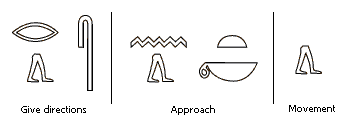[Editor’s note: This is the second of an ongoing series that examines the rise of writing – and therefore reading – around the world. We will be looking at the major developments and forces that shaped the written languages we use today.]
In Part 1 of this series, we looked at the very beginnings of humans’ use of written language, transitioning from the pictographs of cave art to the Sumerians’ use of cuneiform, a syllabic representation of their oral language. Today, we’re going to look at another ancient civilization’s move to true writing – the Egyptians – and the very different path they took to achieve the same end.
Instead of cuneiform, the Egyptians developed hieroglyphs, defined as characters in a system of writing in which symbols represent both objects and ideas (intangibles, such as life, joy, and movement). The ancient Greeks were the first to use the term hieroglyph (two words that together meant “sacred carving”) to describe the characters they observed carved on Egyptian monuments.
The earliest evidence of an Egyptian hieroglyphic system dates back to about 3300 or 3200 BCE, which puts it right about the same time the Sumerians developed their cuneiform system. Scientists continue to debate which of the written forms is older, as archaeological evidence can’t narrow down the time frame further. It’s quite possible that both forms developed independently at the same time; they are different enough in structure that it’s clear they did not develop from a common ancestor. Other ancient cultures, such as those in China and even the Americas used similar writing systems at later times, but, again, there was no common ancestor language, and none of those systems descended from the Egyptian hieroglyphs. Only a small portion of the Egyptian population – mostly royalty, priests, and civil officials – used hieroglyphs as a matter of course, because they were difficult to learn and time consuming to create. As the ancient Egyptian word for hieroglyphs translates literally to the “language of the gods,” students of history can fully understand their importance in this society, whether for religious purposes or for the recording of important civil documents.
The Egyptian hieroglyphic system contained between 700 and 800 basic symbols, known as glyphs. This number grew to about 1,500 in the twilight days of the civilization, primarily because the priests became more interested in writing religious texts. They wrote the hieroglyphs in long lines that moved from right to left or left to right and from top to bottom, using no spaces or punctuation. You can tell the direction of the writing, though, by looking at the way the animals and people face – they always look towards the beginning of the line. The glyphs are divided into two groups: phonograms, ones that represent sounds, and ideograms, ones that represent objects or ideas. The Egyptians constructed words using the two types in combination. Readers need to recognize both phonograms and ideograms and understand how they relate to each other to determine the significance of a word or phrase within the lines.
Phonograms represented the sounds of single consonants and of combinations of consonants; the writers included no vowels, so it’s impossible for us to know exactly how hieroglyphic texts were pronounced. When speaking the words, people may have added vowel sounds to distinguish words that, in written form, appeared identical. Ideograms represented one of two things: either the specific object written or something closely related to it. These were referred to as determinatives because their position in combination with the phonograms could change the meaning of what was written. As an example, the glyph of a pair of legs might represent the idea of movement, a noun. Combined with a second glyph, though, the meaning could change so that it represented the verb to approach, or combined with still another glyph, it could convey the concept of giving directions. Using the phonogram-determinative combinations allowed the Egyptians to develop thousands of written words without having to create a single distinct glyph for each thing, action, or concept.

Glyphs combined with determinatives convey different meanings
As we’ve mentioned, hieroglyphs were very time consuming to create, so the Egyptians developed a cursive script called hieratic in the early years of hieroglyphic use. The characters of the hieratic script were based on hieroglyphic symbols, but they were simplified to the point that they were quite dissimilar to the original glyphs. Hieratic was used for most of the writing done with reed pens and ink on papyrus paper and showed up primarily in religious texts. In the 7th century BCE, the Egyptians began using a script called demotic, one that was even more simplified than the hieratic. This popular script, whose name originated with Herodotus, developed from a northern variant of the hieratic script. It was used for writing business, legal, scientific, literary, and some religious documents, and it was written almost exclusively from right to left in horizontal lines.
After 2,600 years of reasonable stability, the hieroglyphs underwent a major change between 305–30 BCE as Egypt was conquered by the Greeks and entered Ptolemaic Dynasty. During this time, the Egyptians created many new glyphs, primarily due to the priests who became interested in writing religious texts in a more obscure and secretive manner. They often used the new glyphs to form specialized codes and puns that could only be understood by a group of religious initiates. Then, after the Greeks – and the Egyptians under their rule – fell to the Romans in 30 BCE, the use of hieroglyphs declined. The last hieroglyphic inscription that can be dated specifically was written in 394 CE. For approximately 1,800 years, the once-dominant hieroglyphs became obscure and untranslatable, until the Rosetta Stone was found and decoded. We’ll be discussing the Stone in more detail later on in this series, so stay tuned.
Next up: Indo-European languages
References:
International World History Project (http://history-world.org/)
https://www.omniglot.com/writing/egyptian.htm

10 thoughts on “The History of Writing and Reading – Part 2: Egyptian Forms”